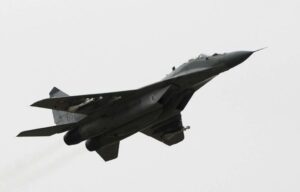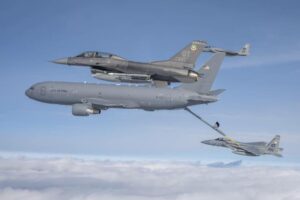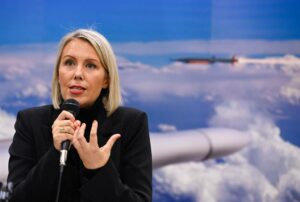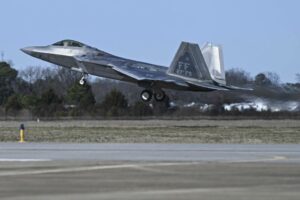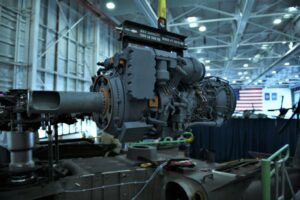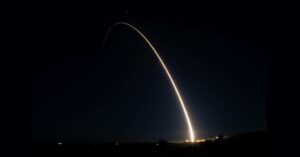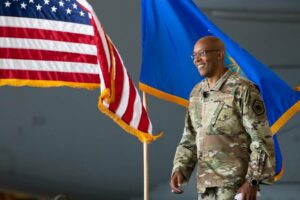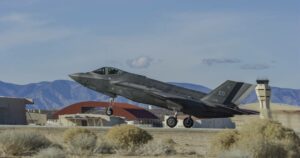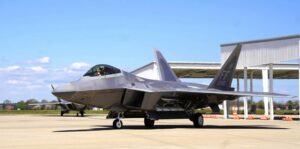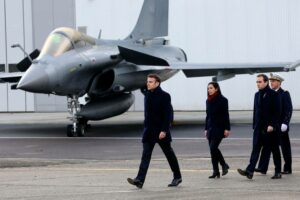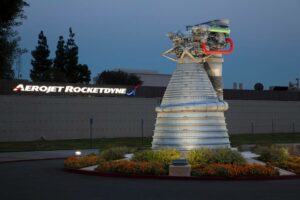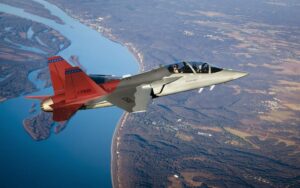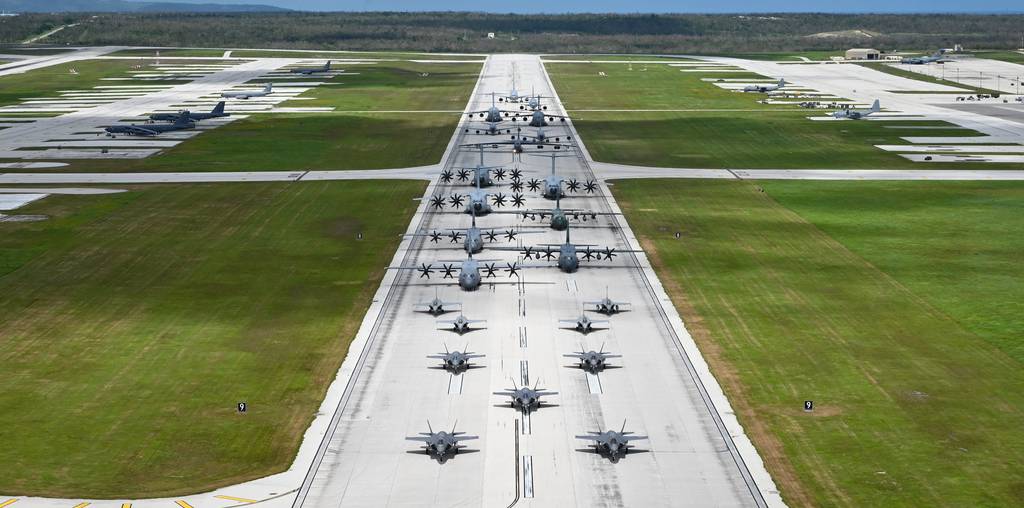
OVER THE MARIANA ISLANDS — The airmen have five seconds.
Poised next to nearly three tons of cargo — plastic barrels of water — these loadmasters aboard a C-17 airlifter know the stakes. If they airdrop the precious supplies too early, the cargo ends up in the Pacific Ocean. Too late? Same result.
When the countdown hits zero, the barrels zip down the open ramp and dip off the edge. White parachutes unfurl and the cargo sails to its destination: a dirt strip on the edge of Tinian, the tiny island outpost 100 miles north of Guam.
This practice run is part of a bigger test, a race with higher stakes: How quickly could the Air Force respond to a Chinese attack on Taiwan?
“We stand united with our partners and allies for a free and open Indo-Pacific,” said Gen. Mike Minihan, the Air Force’s top mobility officer. “We’re ready, we’re integrated ... and we can handle any mission set that our civilian leaders choose for us to accomplish.”
The Pentagon views China as America’s top competitor in military strength, technology development and global influence. Defense leaders are also wary of Beijing’s growing aggression toward Taiwan, the democratically self-governed island that maintains military and trade ties with the United States but is claimed by China.
That’s why, for the first time, the U.S. Air Force’s massive biennial training exercise for airlift and aerial refueling brought together around 3,000 troops and 70 mobility aircraft, such as the C-130 and A400 airlifters and the KC-46 tanker, from the United States and six allies to the Pacific.
For two weeks in July, the training, known as Mobility Guardian, helped solidify the use of the so-called “Second Island Chain” — the string of archipelagos from Japan to the Mariana Islands to Indonesia — as a key logistics hub for the U.S. and its allies in a future war.
It was a test of several crucial questions: How quickly can the Air Force get there? What and who does it need to bring? And can the airmen do it all themselves?
The answers began more than 8,000 miles away in Charleston, South Carolina.
‘Back to the future’
On a scorching, muggy morning at Joint Base Charleston July 3, Air Force Times began an exclusive 10-day trip with Air Mobility Command to Andersen Air Force Base in Guam.
Airmen milled around the Installation Deployment Readiness Center, a one-stop shop for last-minute paperwork checks, briefings and vaccinations before shipping overseas.
They were preparing to deploy as the 437th Air Expeditionary Wing, the unit that would lead Mobility Guardian from a makeshift headquarters at Andersen. Their goal was to bring to life the Air Force’s vision of a speedier, more holistic approach to combat tours.
It marks a fundamental shift in how the Air Force thinks about fighting in the Pacific.
For the past two decades, the war on terrorism has relied on a stream of airmen who cycle through well-established bases around the world. Sometimes that requires deploying an entire squadron for one mission; other times, airmen are tapped piecemeal from different squadrons or bases to fill open jobs overseas.
Now airmen who work under the same wing at home will deploy together as one team, with a built-in air staff to manage missions and morale. Along with more predictable schedules and ample training, the Air Force hopes the new approach will lead to more capable expeditionary units that can function away from brick-and-mortar bases.
“[U.S. Central Command], quite frankly, has created some bad habits with how we employ our assets,” said Lt. Col. Jake Parker, Mobility Guardian’s lead planner. “We have a very robust infrastructure, and we got so reliant on that, that now we don’t have the ability to pivot from one place to the next.”
For 437th Operations Group commander Col. Carlos Berdecía, Mobility Guardian was a chance to tackle new challenges after the U.S. military’s tumultuous 2021 withdrawal from Afghanistan.
“Joint Base Charleston had a hangover from [Operation Allies Refuge], because we did so well. We were the last ones on the ground,” said Berdecía, a career C-17 Globemaster III pilot who served as expeditionary wing commander for the exercise. “There had to be something to say, ‘I need to focus on what’s next.’ ”
Revamping how the Air Force goes to war means reviving practices like deployment lines that fell by the wayside during the war on terrorism — and before today’s youngest airmen were born.
“It’s almost back to the future,” Berdecía said. “There’s some knowledge that hasn’t been retained. Breaking open [regulations] that haven’t been looked at, making sure we’re doing things by the book, is really important. That muscle memory isn’t necessarily there, so we’re trying to build that right now.”
Outside the deployment center, tan and olive luggage bound for Guam and Australia lined the parking lot and piled up on trucks; a staffer handed out first-aid supplies in the lobby.
Airmen filed inside for briefings on what lay ahead. Mobility Guardian is an opportunity to show the world what the U.S. and its allies can do, they were told, so take it seriously. Be respectful to locals as Guam recovers from Typhoon Mawar, the strongest storm to hit the U.S. territory since 2002.
And they were warned: Guam is a popular destination for Chinese intelligence officers, so be wary of strangers in bars and the questions they ask. For added protection, troops were told to turn off geolocation services on their devices for the duration of the exercise.
Then airmen headed down the hallway to a counter where administrators ensured their paperwork was in order, from survival training certificates to medical documents, and picked up printed deployment orders and dog tags.
Master Sgt. Justin Braden, a combat communications specialist, said it was a chance to interact with the airmen, soldiers and Marines who would rely on that equipment for their own training around the region.
“We’re supposed to go with generators and nothing, and set up initial comms,” Braden said aboard a C-17 Globemaster III as it prepared to leave Charleston for Australia. “We’re getting to do more of what we’re supposed to be doing … when you go on deployment.”
Getting there
The exercise formally kicked off July 5 with one of its toughest challenges: rushing dozens of planes and thousands of airmen to the Pacific in record time.
Air Force leaders have said that deploying in a matter of hours or days by air, rather than weeks or months by sea, can deter Chinese and North Korean aggression in the region. It also gives commanders more options to respond if a crisis erupts.
“No one wants a conflict. We’re doing this to show our adversary that we want peace in [U.S. Indo-Pacific Command] and we can all exist here together,” said Lt. Col. Jason Walker, 61st Expeditionary Airlift Squadron commander. “But this is the line. … Do not cross it.”
The 8,100-mile trek from South Carolina to Guam starts with a 10-hour flight to Honolulu, plus another seven hours to the southernmost point in the North Pacific. Getting to Japan or Australia takes even longer.
For comparison, the journey is farther than Afghanistan, and the Pacific lacks the network of large, U.S.-run bases across Europe and the Middle East where airmen are used to stopping for sleep and equipment. And though Air Mobility Command regularly travels around the Pacific, those flights are scheduled farther in advance and with fewer planes at once.
Most airmen made the trip in three or four days; all reached their destination within a week or so. Minihan called the outcome a “game changer.”
Walker said his airmen flew from Arkansas to Guam in 38 hours, and to the Philippines in 42 hours — a first for Little Rock Air Force Base’s C-130s, which fly lower and slower than larger cargo jets. One British airman boasted that the Royal Air Force was able to reach the Pacific in under 21 hours.
It was made possible by maintainers who stretched their limits and tackled last-minute problems; schedulers who navigated the puzzle of aircraft and crew availability, cargo and passengers, destinations and timing; and pilots who worked in shifts between naps in the back of the aircraft.
Still, crews faced plenty of hiccups. Some were turned away from Australia due to bureaucratic complications; others were slowed by weather, broken jets, disconnects when new crews weren’t ready to go, or small gas tanks that required frequent refueling.
C-17 maintainers from Travis AFB in California were stuck in Hawaii when their jet broke en route to Guam, said Master Sgt. David Moser, a Globemaster III maintenance superintendent. Another jet did reach Andersen, but airmen couldn’t offload their equipment or personal belongings because of confusion over biosecurity inspections. Then the team fell several hours behind schedule because jet fuel trucks were slow to arrive and carried less gas than those at Travis.
“It’s what Gen. Minihan wants ... to see,” Moser said. “How do you work when you’re … stressed out?”
“We need to see how we fail when it fails, so that way, when real-world situations do arise … we can be more proactive,” he said.
Long flights presented an opportunity for Air Mobility Command to study how to safely handle extensive missions across several time zones.
For Mobility Guardian, the command allowed its crews to take stimulants like Modafinil or sleeping pills to control their circadian rhythm. “Go” and “no-go” pills are commonly used in the combat and intelligence communities but have remained off-limits for mobility pilots.
“A lot of the crews reported feeling better than expected when we got here,” said Walker, who said he opted for sleep and caffeine rather than drugs. “I wouldn’t do it again tomorrow. … But it definitely wasn’t as bad as we thought it would be.”
In the fight
On the ground in Guam, another experiment was unfolding.
The Air Force has long relied on the rest of the U.S. military to set up its bases of operations around the world. Now Air Mobility Command wants to become the service’s own “maneuver force” that opens airfields and launches flight operations.
For Mobility Guardian, that job fell to the 621st Contingency Response Group. The Air Force’s in-house rapid-reaction teams specialize in clearing the way for air operations and directing forces in austere locations.
A team of 88 contingency response airmen began arriving in Guam on July 3, where they marshaled themselves into the airfield and got to work building the exercise’s deployed headquarters on the far edge of the flightline at Andersen AFB.
Over the course of six days, the exercise’s footprint in Guam grew from 25 people and one aircraft to 1,100 people and 27 aircraft from seven countries.
First came satellite communications, so the contingency response team could talk to the aircraft that began arriving within hours. Then came a logistical hub where airmen could unload planes and prepare them for their next flights out.
The site became known as Forward Operating Base LFG (“let’s f***ing go”) — a camp of about a dozen air-conditioned, generator-powered trailers arrayed around a small hangar filled with aeromedical evacuation supplies, airdrop cargo and towering stacks of water bottles. A black flag bearing a skull and crossbones fluttered overhead.
Contingency response handed off control of the base to the air expeditionary wing staff at noon on July 10 — 54 hours after Berdecía’s team landed in Guam.
That put the wing’s air staff in charge of ensuring life in the field ran smoothly: Procuring more than 650 roast beef sandwiches for boxed lunches. Ensuring dozens of port-a-potties were regularly serviced. Figuring out who, exactly, owned the fleet of 53 rental cars.
It was a smaller, more austere footprint than the Air Force had envisioned. Because of Typhoon Mawar, the Category 4 storm that hit Guam May 24, the Federal Emergency Management Agency had taken over an area at Guam’s international airport that the Air Force had planned to use. That brought more jets and airmen to Andersen, where leaders worried that the influx of people would strain already-struggling resources.
“It’s a very congested operation … a ballet of those elephants out there,” 621st Contingency Response Group commander Col. Daniel Mollis said.
Airmen charted each day’s planned missions on large whiteboards and handed out paper copies of their flight profiles — a way to navigate differences in each country’s security clearances and software that wouldn’t list non-U.S. flights.
Leaders tasked airmen with moving troops and equipment in support of other U.S. and allied exercises around the Pacific, like the U.S. Air Force’s Northern Edge. When not on real-world missions, they practiced skills like aeromedical evacuation.
Island-hopping in the Pacific offered the chance to practice refueling aircraft with gas pumps on the ground, and with engines running, to reduce reliance on tanker jets. The Air Force found there’s a greater demand for those operations across the joint force than expected, a spokesperson said after the exercise.
Airmen also practiced launching and landing airlifters at steep angles on unlit, short runways. Those “assault landings” can protect aircraft from incoming fire, and prevent them from damaging the plane by overshooting smaller-than-usual airstrips.
Pilots and crews flew missions on jets from other countries to learn from their foreign counterparts, and maintainers swapped tips on how to repair the airframes they have in common with their allies.
Airman 1st Class Trenton McGregor, a C-17 maintenance crew chief, said the exercise pushed his team to anticipate a jet’s needs before it returned to base, and to work more efficiently with fewer people and tools.
“You have to learn to adapt and ... spread out between different people,” he said. “Guys that normally don’t do my job are having to do my job, and I’m having to go out and help these guys that I don’t know too much about. We’re all learning on the fly.”
Unexpected emergencies tested the coalition, too.
On July 10, the U.S. Coast Guard called for help to save 11 people whose 21-foot boat was in danger of capsizing in rough waters off the coast of Rota in the Northern Mariana Islands, the U.S. Air Force said. Planners at Andersen dispatched French A400 and Canadian CC-130J airlifters to find and maintain contact with the boat until U.S. Navy rescue forces arrived.
Mobility Guardian participants also rescued a hiker who fell down a cliff, and transported a 10-day-old newborn with an enlarged heart from Yokota Air Base in Japan to the United States for emergency medical care.
Capt. Mike Thomas, who guided the exercise’s daily operations as the agnostic “white cell,” said the coalition planning cell did far better than expected at navigating the daily grind.
“The scariest thing that you can see as a mission commander or an air planner is if you walk into a mission planning cell and it’s quiet, because that means that nobody’s talking, nobody’s actually highlighting problems,” he said. “When we walked into the coalition mission planning cell, it was just humming.”
Coalition participants praised the chance to work through problems unlike those they faced with the U.S. in Afghanistan and Iraq.
“It’s funny when you’re working on each side of the [International Date Line], because sometimes we are [on] the 14th, but some guys are still [on] the 13th, and even when you’re trying to discuss in Zulu time, it’s Zulu on which day?” said Col. Franck Bottero, who led France’s delegation to the exercise. “We are using the same procedures, but considering the size and different spokes, I think it’s quite new for us.”
Airmen from multiple countries noted that the American penchant for process meant the U.S. planned missions more cautiously than others, forcing foreign airmen to move slower as well.
“The U.S. has a lot of very well-established systems and processes, which is very required for the large scale that the U.S. forces have. In Australia … some things can be more agile,” said Flight Lt. Peter Spearman, who led Royal Australian Air Force C-17 operations at Mobility Guardian. “That sometimes is useful, especially being able to change regulation when it is limiting us.”
In the coming months, the coalition will try to turn lessons learned into future fixes.
Mobility Guardian highlighted the need to work in smaller teams with enough tools to do the job if others take longer to arrive, to remove the red tape that keeps cargo on jets too long, to ensure all airmen are communicating using the same apps, and to invest in equipment like secure radios and the militarized version of SpaceX’s Starlink.
It has illustrated the frustrations of trying to navigate the Pacific’s many airfields and finicky weather, and the opportunities that arise from sharing airmen and jets.
And it showed airmen that even with a fraction of their team on the ground, demand for air mobility assets never lets up. Berdecía said the exercise proved the difficulty of starting from scratch, even with support from contingency response and the local base.
“We have proven that this concept works,” he said. “We will continue gathering lessons learned, as small as they can be all the way to as large as they can be, and adjust for the next Mobility Guardian and/or real contingency that would call for this type of structure.”
There’s plenty that isn’t ready for primetime yet. But Mobility Guardian showcased what could be: A more self-reliant, swift-moving international air coalition in even the remotest places.
A U.S. Army cavalry squadron, freshly arrived from Hawaii, loitered at the edge of camp on July 13. An airman nodded in their direction.
“The Army’s here now,” he told Berdecía.
Berdecía smiled back. “And look who got them here.”
Rachel Cohen joined Air Force Times as senior reporter in March 2021. Her work has appeared in Air Force Magazine, Inside Defense, Inside Health Policy, the Frederick News-Post (Md.), the Washington Post, and others.
- SEO Powered Content & PR Distribution. Get Amplified Today.
- PlatoData.Network Vertical Generative Ai. Empower Yourself. Access Here.
- PlatoAiStream. Web3 Intelligence. Knowledge Amplified. Access Here.
- PlatoESG. Automotive / EVs, Carbon, CleanTech, Energy, Environment, Solar, Waste Management. Access Here.
- PlatoHealth. Biotech and Clinical Trials Intelligence. Access Here.
- ChartPrime. Elevate your Trading Game with ChartPrime. Access Here.
- BlockOffsets. Modernizing Environmental Offset Ownership. Access Here.
- Source: https://www.defensenews.com/news/your-air-force/2023/08/09/inside-the-air-forces-massive-mobility-war-game-in-the-pacific/
- :has
- :is
- :not
- :where
- $UP
- 000
- 1
- 10
- 100
- 11
- 12
- 13
- 1st
- 2021
- 2023
- 23
- 24
- 25
- 27
- 53
- 7
- 70
- 8
- 9
- a
- ability
- Able
- About
- accomplish
- across
- actually
- adapt
- added
- adjust
- administrators
- advance
- AFGHANISTAN
- After
- again
- agency
- agile
- ahead
- AIR
- Air Force
- aircraft
- airdrop
- airport
- Alexander
- All
- allowed
- along
- also
- American
- an
- and
- Andersen
- Another
- answers
- anticipate
- any
- appeared
- approach
- apps
- ARE
- AREA
- areas
- arise
- arkansas
- Army
- around
- arriving
- AS
- Assets
- At
- attack
- Australia
- Australian
- availability
- away
- back
- Bad
- baker
- barrels
- bars
- base
- BE
- became
- because
- become
- Beef
- been
- before
- began
- behind
- being
- Better
- between
- bigger
- Black
- boat
- book
- born
- both
- bound
- Breaking
- bring
- British
- Broke
- Broken
- brought
- build
- Building
- built-in
- bureaucratic
- but
- by
- caffeine
- california
- call
- called
- came
- Camp
- CAN
- Canada
- Canadian
- capable
- care
- Career
- Cargo
- Carolina
- carried
- cars
- Category
- cautiously
- cell
- Center
- central
- certificates
- challenges
- Chance
- change
- Changer
- charge
- Charlotte
- Checks
- chief
- China
- chinese
- Chinese intelligence officers
- Choose
- claimed
- class
- Clearing
- Coast
- cohen
- combat
- coming
- Common
- commonly
- commonwealth
- communicating
- Communications
- Communities
- comparison
- competitor
- concept
- Conduct
- conflict
- confusion
- considering
- contact
- continue
- control
- copies
- could
- countdown
- Counter
- countries
- country’s
- course
- created
- crisis
- Cross
- crucial
- cycle
- daily
- damaging
- DANGER
- Daniel
- Date
- David
- day
- Days
- decades
- Defense
- definitely
- delegation
- Demand
- deploy
- deployed
- deploying
- deployment
- destination
- destinations
- Development
- Devices
- DID
- differences
- different
- Difficulty
- Dip
- directing
- direction
- dirt
- discuss
- do
- documents
- does
- Dog
- doing
- Dont
- down
- dozen
- dozens
- Drugs
- due
- duration
- during
- each
- Early
- East
- Edge
- efficiently
- emergency
- ends
- Engines
- enough
- ensure
- ensuring
- Entire
- equipment
- especially
- Europe
- Even
- exactly
- Exclusive
- Exercise
- exist
- expected
- experiment
- extensive
- faced
- FAIL
- fails
- far
- Federal
- fewer
- field
- fighting
- filed
- fill
- filled
- Find
- Fire
- First
- first time
- five
- FLEET
- flight
- Flights
- Focus
- Footprint
- For
- Force
- Forces
- foreign
- Formally
- Forward
- found
- four
- fraction
- France
- Frederick
- Free
- French
- frequent
- from
- front
- Frustrations
- Fuel
- function
- fundamental
- funny
- future
- Galaxy
- game
- GAS
- gathering
- Gen
- generators
- get
- getting
- gives
- Global
- Go
- goal
- Goes
- greater
- Ground
- Group
- Growing
- Guard
- guardian
- had
- handle
- Have
- having
- hawaii
- he
- headed
- Headquarters
- Health
- Heart
- helicopter
- helicopters
- help
- helped
- her
- here
- higher
- Highlighted
- highlighting
- his
- Hit
- Hits
- holistic
- Home
- hopes
- HOURS
- How
- How To
- HTTPS
- Hub
- i
- if
- iii
- image
- images
- important
- in
- Incoming
- Indonesia
- influence
- influx
- Infrastructure
- initial
- inside
- installation
- integrated
- Intelligence
- interact
- International
- into
- Invest
- iraq
- island
- Islands
- IT
- ITS
- james
- Japan
- Japanese
- Jets
- Job
- Jobs
- joined
- joint
- journey
- jpg
- July
- just
- Justin
- Key
- Know
- knowledge
- known
- Korean
- Lam
- landing
- lands
- large
- larger
- Last
- Late
- launches
- launching
- lay
- lead
- leaders
- LEARN
- learned
- learning
- Leave
- Led
- left
- less
- Lessons
- Lessons Learned
- Lets
- lfg
- Life
- like
- limits
- Line
- lined
- List
- little
- Livingston
- Lobby
- local
- locations
- logistics
- Long
- longer
- Look
- looked
- Lot
- lower
- made
- magazine
- maintain
- maintains
- maintenance
- Making
- manage
- management
- many
- March
- Marine
- massive
- master
- Matter
- May..
- means
- meant
- medical
- medical care
- Memory
- Michael
- Middle
- Middle East
- mike
- Military
- Mission
- missions
- mobility
- months
- more
- morning
- move
- moving
- much
- multiple
- my
- Navigate
- navigating
- Near
- nearly
- necessarily
- Need
- needs
- network
- never
- New
- New Zealand
- next
- normally
- North
- noted
- nothing
- now
- ocean
- of
- off
- offered
- officers
- on
- once
- ONE
- ones
- open
- opens
- operated
- operating
- operation
- Operations
- opportunities
- Opportunity
- Options
- or
- order
- orders
- Other
- Others
- our
- out
- Outcome
- over
- overseas
- own
- owned
- Pacific
- Pacific Ocean
- Paper
- paperwork
- parking
- part
- participants
- partners
- past
- peace
- pentagon
- People
- personal
- Peter
- Philippines
- picked
- pilot
- Pilots
- Pivot
- Place
- Places
- Planes
- planned
- planning
- plastic
- plato
- Plato Data Intelligence
- PlatoData
- Plenty
- plus
- Point
- policy
- Popular
- poses
- possible
- Post
- practice
- practices
- Praised
- Precious
- Predictable
- Prepare
- prepared
- Prepares
- preparing
- presented
- prevent
- Proactive
- problems
- procedures
- process
- processes
- Profiles
- protect
- protection
- proved
- proven
- pumps
- pushed
- put
- puzzle
- Questions
- quickly
- Race
- Ramp
- rather
- reach
- reached
- Readiness
- ready
- real
- real world
- really
- reasons
- receive
- record
- Recovers
- Red
- reduce
- Refueling
- region
- regularly
- Regulation
- regulations
- reliance
- rely
- remained
- remote
- remove
- repair
- Reported
- reporter
- required
- requires
- rescue
- Resources
- Respond
- response
- REST
- result
- retained
- rhythm
- right
- robust
- Rock
- Route
- royal
- Run
- running
- s
- safely
- Said
- Sam
- same
- satellite
- Save
- say
- Scale
- schedule
- scheduled
- scratch
- SEA
- Sean
- seconds
- secure
- security
- see
- senior
- seriously
- Services
- set
- seven
- several
- sharing
- shift
- Shifts
- Shipping
- Shop
- Short
- show
- showcased
- showed
- side
- since
- site
- situations
- SIX
- Size
- skills
- sleep
- slow
- small
- smaller
- smoothly
- So
- Software
- some
- something
- sometimes
- South
- South carolina
- specialist
- specialize
- spokesperson
- spread
- Stacks
- Staff
- stand
- starlink
- Starting
- starts
- States
- Still
- stopping
- Storm
- stream
- strength
- String
- Strip
- structure
- Study
- such
- support
- supposed
- sure
- survival
- Systems
- tackle
- Taiwan
- Take
- taken
- takes
- Talk
- talking
- Tanks
- tape
- Tapped
- team
- teams
- tech
- Technology
- Technology Development
- territory
- Terrorism
- test
- tested
- than
- that
- The
- The Future
- the joint
- The Philippines
- The Washington Post
- the world
- their
- Them
- themselves
- then
- There.
- These
- they
- thing
- things
- think
- Thinks
- this
- those
- though?
- thought
- thousands
- three
- Through
- Ties
- time
- times
- timing
- tips
- to
- today’s
- together
- tomorrow
- tons
- too
- tools
- top
- toward
- trade
- trailer
- Training
- transported
- travels
- trip
- Trucks
- try
- TURN
- Turned
- two
- type
- u.s.
- U.S. Air Force
- U.S. Navy
- under
- unfolding
- unit
- United
- United States
- units
- unlike
- until
- us
- use
- used
- using
- Venom
- version
- very
- views
- vision
- walked
- walker
- want
- wants
- war
- was
- washington
- washington post
- Watch
- Water
- Water Bottles
- Waters
- Way..
- we
- Weather
- week
- Weeks
- WELL
- were
- What
- when
- which
- white
- WHO
- whose
- why
- will
- Wing
- with
- withdrawal
- within
- Work
- worked
- working
- works
- world
- worried
- would
- yet
- you
- Youngest
- Zealand
- zephyrnet
- zero
- Zip
- zones

